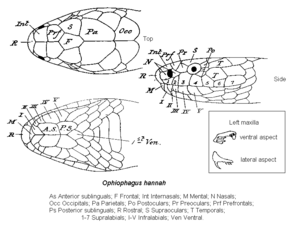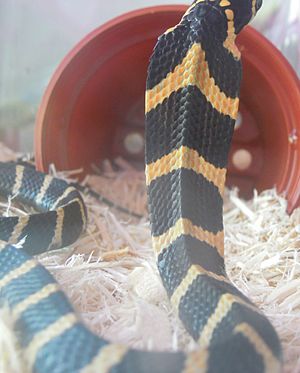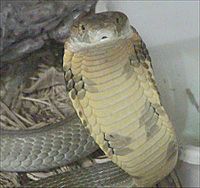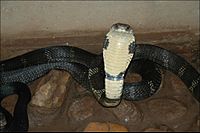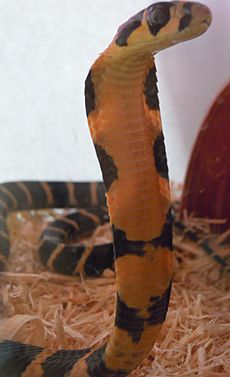King cobra facts for kids
Quick facts for kids King cobra |
|
|---|---|
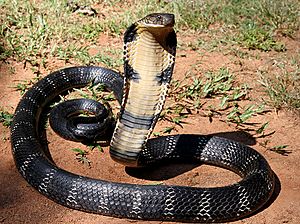 |
|
| Conservation status | |
| Scientific classification | |
| Genus: |
Ophiophagus
|
| Species: |
hannah
|
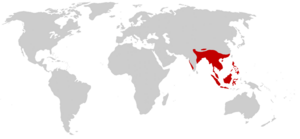 |
|
| Distribution of the king cobra | |
| Synonyms | |
|
Genus-level:
|
|
The king cobra (Ophiophagus hannah) is a huge, venomous snake that lives in forests across India and Southeast Asia. It is known as the longest venomous snake in the world. Adult king cobras are usually about 3.18 to 4 meters (10 to 13 feet) long. The longest one ever recorded was 5.85 meters (19 feet) long!
This snake is the only member of its group, called Ophiophagus. It mainly eats other snakes, but sometimes it also hunts lizards and rodents. The king cobra is very venomous and can be dangerous if it feels threatened. However, it usually tries to avoid people. In India, the king cobra is a national symbol and is important in old stories and traditions. It is a Vulnerable animal because its home is being destroyed.
Contents
About the King Cobra's Name
The scientific name for the king cobra is Ophiophagus hannah. The word Ophiophagus comes from Greek words meaning "snake-eater." This name was given to the snake in 1864 by a scientist named Albert Günther. It perfectly describes what the king cobra loves to eat!
Scientists have studied the king cobra's DNA. They found that it is an early relative of mamba snakes, not the Naja cobras you might know. This shows how unique the king cobra is.
What the King Cobra Looks Like
The king cobra has skin that is usually olive green. It has black and white stripes on its body that meet near its head. Its head has 15 smooth, dull-colored scales with black edges. The front of its mouth is rounded, and its tongue is black.
It has two fangs at the front of its mouth, which it uses to inject venom. It also has other teeth further back. Its large eyes have a golden color and round pupils. When it feels threatened, it can spread its neck to form an oval-shaped hood. This hood has smooth, olive-green scales and two black spots. Its tail is yellowish-green with black markings.
Young king cobras look different from adults. They are black with V-shaped white, yellow, or light brown stripes. These stripes point towards their head. As they grow older, these bright colors often fade.
Adult king cobras are typically 3.18 to 4 meters (10 to 13 feet) long. The longest one ever found was 5.85 meters (19 feet) long. Male king cobras are usually larger and lighter in color than females, especially during mating season. The biggest king cobra ever recorded was 5.59 meters (18 feet 4 inches) long. It was caught in Thailand.
The king cobra is much bigger than other cobra species. Its hood is also narrower and has a longer stripe on its neck. Its head can look very big and strong when it's fully grown. Like most snakes, it can open its jaws very wide to swallow large prey.
Where the King Cobra Lives
The king cobra lives in many parts of South and Southeast Asia. You can find it in India, Nepal, Bhutan, Bangladesh, Myanmar, southern China, Cambodia, Thailand, Laos, Vietnam, Malaysia, Singapore, Indonesia, and the Philippines. It can live in places up to 2,000 meters (6,500 feet) high.
In India, it lives in many different regions, from the northern mountains to the southern coasts. It also lives on Baratang Island.
Behavior and Ecology
Like other snakes, the king cobra uses its forked tongue to "smell" its surroundings. It picks up tiny scent particles and moves them to a special organ in the roof of its mouth. This helps it find prey. When it smells something, it flicks its tongue to figure out exactly where the prey is. It can also feel vibrations in the ground and detect moving prey from almost 100 meters (328 feet) away.
After biting its prey and injecting venom, the king cobra swallows the animal whole. Its jaws are very flexible, so it can swallow prey that is much bigger than its head. King cobras usually hunt during the day, but they have also been seen at night sometimes.
Diet
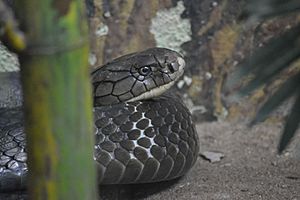
The king cobra's main food is other snakes and lizards. It eats snakes like the Indian cobra, banded krait, rat snake, and even pythons. It also hunts Malabar pit vipers and hump-nosed pit vipers by following their scent. Sometimes, if food is hard to find, it will eat small birds or other lizards. After a big meal, a king cobra can go for many months without eating again. This is because its body uses energy very slowly.
Predators
Not many animals hunt king cobras. Mongooses and large birds like eagles and hawks are some of their natural enemies. Mongooses are special because they have a natural resistance to snake venom. This allows them to hunt and kill king cobras.
Defense
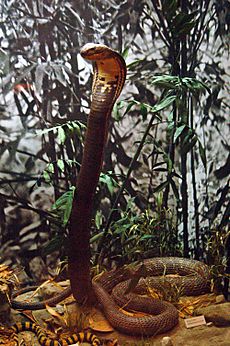
King cobras are not usually aggressive towards humans. They prefer to slither away when disturbed. However, they are known to fiercely protect their eggs and will attack quickly if someone gets too close to their nest. When a king cobra feels threatened, it raises the front part of its body, spreads its hood, shows its fangs, and makes a loud hissing sound.
King cobras have very strong venom. A bite can cause serious problems very quickly. Most people who are bitten by king cobras are snake charmers. Bites from king cobras are quite rare.
It's important to know that a king cobra can be easily annoyed by things moving close to it. When it raises its body, it can still strike a long distance forward. It can also bite more than once in a single attack.
Growling Hiss
The king cobra's hiss sounds different from most other snakes. It's a much lower sound, almost like a "growl." Most snakes hiss at a high pitch, but the king cobra's growl is a low sound. This is because it has special air sacs in its windpipe that act like resonating chambers, making the sound deeper.
Reproduction and Life Cycle
The king cobra is the only snake that builds a nest for its eggs. The female snake uses dry leaves and other plant material to build a mound. These nests are usually at the base of trees and can be quite large. They have several layers and a chamber inside where the female lays her eggs.
A female king cobra lays between 7 and 43 eggs. The eggs hatch after about 66 to 105 days. The temperature inside the nest can change, but the female stays near her nest for a long time, sometimes up to 77 days. When they hatch, baby king cobras are about 37.5 to 58.5 centimeters (15 to 23 inches) long.
Even baby king cobras have venom that is as strong as an adult's. They are very alert and can be aggressive if disturbed. A king cobra usually lives for about 20 years in the wild.
King Cobra Venom
The king cobra's venom is very powerful. It contains substances that affect the victim's nervous system and heart. These substances are produced in special glands behind its eyes.
A king cobra can deliver a large amount of venom in one bite. The venom affects the victim's central nervous system. This can cause severe pain, blurry vision, dizziness, and sleepiness. Eventually, it can lead to paralysis. If the bite is serious, it can cause the heart and blood system to fail, and the person can fall into a coma. Death can happen quickly, sometimes within 30 minutes, because the person stops breathing.
It is very important to get proper and immediate medical treatment if someone is bitten by a king cobra. There is a special medicine called antivenom that can help. Antivenom is made from horses and is produced in India and Thailand. In Thailand, a special root from the turmeric plant has also been shown to help against the venom.
Not every king cobra bite injects venom, but all bites are considered very serious and need medical attention. The chance of dying from a king cobra bite can vary, but it is very high without treatment.
Threats to King Cobras
In Southeast Asia, the biggest threat to king cobras is the destruction of their homes. Forests are being cut down to make way for farms and other developments. King cobras are also hunted for their meat, skin, and for use in traditional medicine.
Protecting King Cobras
The king cobra is a protected species. It is listed in CITES Appendix II, which means its trade is controlled. It is also protected by law in China, Vietnam, and India. In India, killing a king cobra can lead to up to six years in prison.
Cultural Significance
In Myanmar, there is a special ritual involving a king cobra and a female snake charmer. The charmer is a priestess who sometimes has tattoos. At the end of the ritual, she kisses the snake on its head.
Some people in the Pakokku clan tattoo themselves with ink mixed with cobra venom. They believe this might protect them from snake bites, but there is no scientific proof that it works.
See also
 In Spanish: Cobra real para niños
In Spanish: Cobra real para niños



